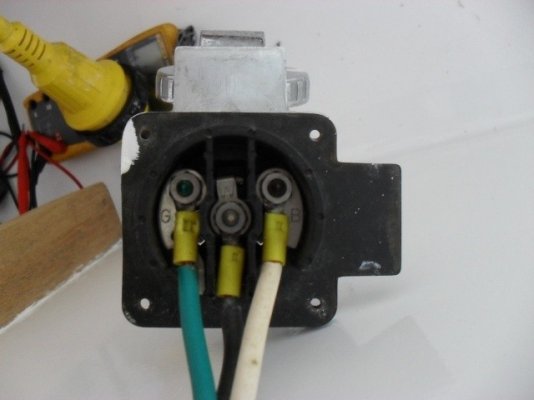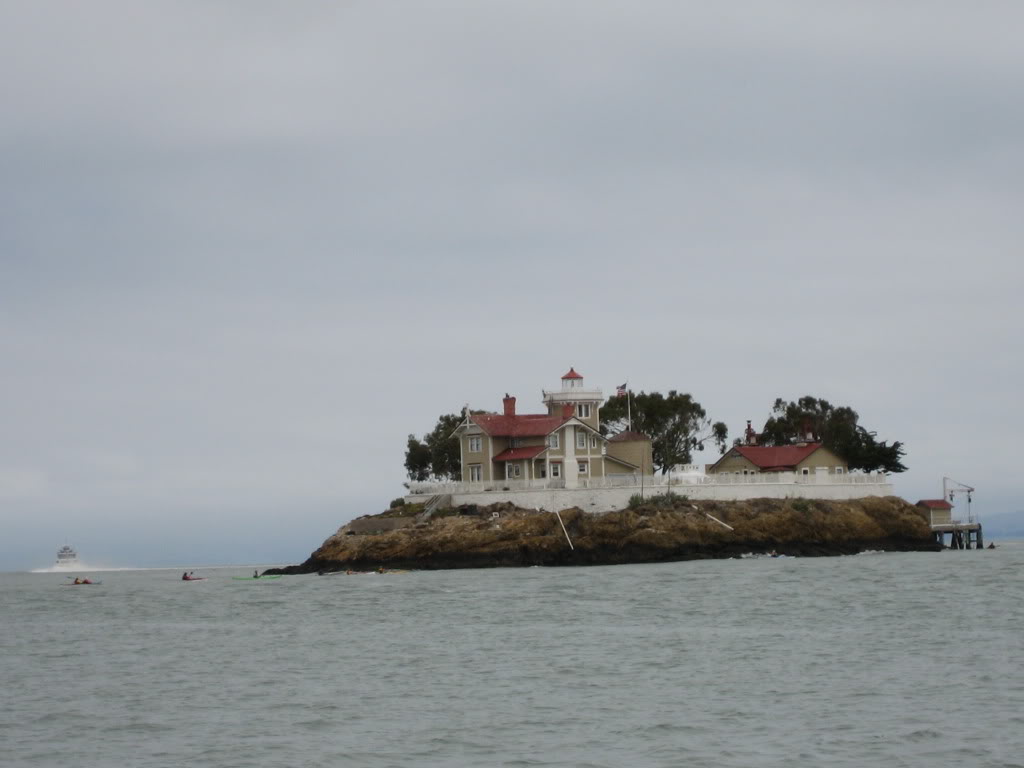So our Monk is powered with a single 30 amp shore power chord. *For a little 36 footer perhaps doable. *I've noticed lately that when I unplug the shore power chord it is warm to the touch @ the boat connection. *We added a 2 burner electric cooktop to the new galley this winter. *A couple of years ago the previous owner had added the 2 HVAC units. *The boat has been around since 1983 and never caught fire but things change, eh? *
Anyway, this past weekend when we unplugged the boat to go anchor out for the night, I noticed that the chord was particularly hot and there was a slight burt rubber smell at the shore power chord and one of the legs of the plug in was discolored and brownish/black. *Hmmm...NOT good. *We anchored out for the weekend and I made sure to only use one major power item at a time late yesterday before we went home (i.e. only one HVAC at a time, only stove, etc.). *I have never had any breakers trip ever. *Just to be safe I had my friends at the service department go through the electrical today to see what we needed to do. *I figured we would have to convert to twin 30 amp service. *Well...come to find out, I am lucky a fire never occurred. *The reason a breaker never tripped is that the main panel breaker is 50 amp not 30 amp! *On top of that, the wiring between generator and panel is undersized for the load. *I don't know if the boat came factory with a 30 amp or if the previous owner installed the 50 amp breaker but it basically was set up to be able to catch fire before a breaker would trip.
After discussing the options and looking at the work that is required to do twin 30 amp or single 50 amp, we have decided we are going to convert the boat this week to single 50 amp service. *I will have to buy one of heck of an expensive new 50 amp shore power chord but it will be a lot less wiring and work on the boat to convert to 50 amp. *My previous boat was equipped with a single 50 amp chord so I am not so much looking forward to that big old heavy chord but it beats burning to the ground. *It is frightening to think how long the boat has been set up with a 50 amp breaker with just a 30 amp service. *Over the years of the additional electrical devises it only stands to reason that something needed to be done but the panel had plenty of breakers to add the additional items. *A smarter person would probably have known something was up but I rarely am accused of being smart. *

Anyway...glad nothing happened beyond a discolored shore power chord and not even a spark on the boat so we caught it in time and will be fixed before the weekend. *In addition to the new 50 amp shore power service, we are going to rewire between generator and panel to make sure we are 100% safe regardless of our power source. *I am just glad we figured out everything in advance.
The moral of the story- if you own or are buying an older trawler, regardless of the build pedigree (or lack thereof where applicable), particularly if there have been any significant changes in the electric configuration/equipment, make sure that all breakers and wiring is properly sized. *I've had multiple marine certified electritians go through my boat previous to this and no issues found and none found by the surveyor so it is proof that sometimes you, as the owner or buyer, need to ask direct and specific questions in an intentional manner during your purchase process or refit process to make sure past wrongs are discovered and made right.
THE GOOD news is that a new slip opened up in our marina with a roof that is 2 feet taller that we are moving the boat to so I no longer have to lower my mast every time I come in or out of the slip like our current one!
Anyway, this past weekend when we unplugged the boat to go anchor out for the night, I noticed that the chord was particularly hot and there was a slight burt rubber smell at the shore power chord and one of the legs of the plug in was discolored and brownish/black. *Hmmm...NOT good. *We anchored out for the weekend and I made sure to only use one major power item at a time late yesterday before we went home (i.e. only one HVAC at a time, only stove, etc.). *I have never had any breakers trip ever. *Just to be safe I had my friends at the service department go through the electrical today to see what we needed to do. *I figured we would have to convert to twin 30 amp service. *Well...come to find out, I am lucky a fire never occurred. *The reason a breaker never tripped is that the main panel breaker is 50 amp not 30 amp! *On top of that, the wiring between generator and panel is undersized for the load. *I don't know if the boat came factory with a 30 amp or if the previous owner installed the 50 amp breaker but it basically was set up to be able to catch fire before a breaker would trip.
After discussing the options and looking at the work that is required to do twin 30 amp or single 50 amp, we have decided we are going to convert the boat this week to single 50 amp service. *I will have to buy one of heck of an expensive new 50 amp shore power chord but it will be a lot less wiring and work on the boat to convert to 50 amp. *My previous boat was equipped with a single 50 amp chord so I am not so much looking forward to that big old heavy chord but it beats burning to the ground. *It is frightening to think how long the boat has been set up with a 50 amp breaker with just a 30 amp service. *Over the years of the additional electrical devises it only stands to reason that something needed to be done but the panel had plenty of breakers to add the additional items. *A smarter person would probably have known something was up but I rarely am accused of being smart. *
Anyway...glad nothing happened beyond a discolored shore power chord and not even a spark on the boat so we caught it in time and will be fixed before the weekend. *In addition to the new 50 amp shore power service, we are going to rewire between generator and panel to make sure we are 100% safe regardless of our power source. *I am just glad we figured out everything in advance.
The moral of the story- if you own or are buying an older trawler, regardless of the build pedigree (or lack thereof where applicable), particularly if there have been any significant changes in the electric configuration/equipment, make sure that all breakers and wiring is properly sized. *I've had multiple marine certified electritians go through my boat previous to this and no issues found and none found by the surveyor so it is proof that sometimes you, as the owner or buyer, need to ask direct and specific questions in an intentional manner during your purchase process or refit process to make sure past wrongs are discovered and made right.
THE GOOD news is that a new slip opened up in our marina with a roof that is 2 feet taller that we are moving the boat to so I no longer have to lower my mast every time I come in or out of the slip like our current one!


